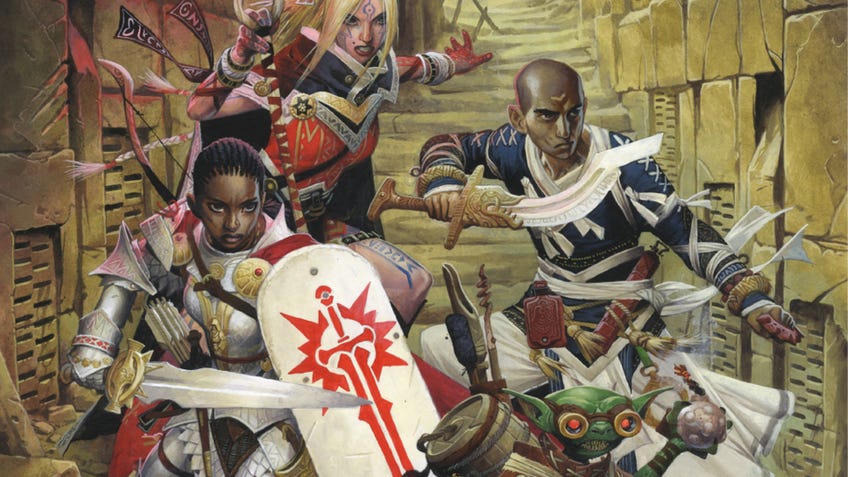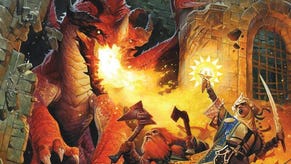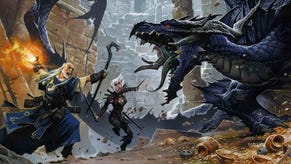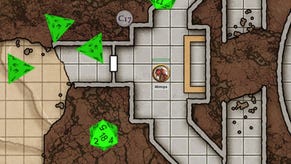Pathfinder Adventure Path creators on setting the gold standard in tabletop RPG campaigns
On the right Path.
Ask any game master to create a new tabletop RPG campaign from scratch, and you can expect that GM to spend hours upon hours designing encounters and scenarios to challenge their players. The amount of time and effort required to plot out an individual session, let alone an entire campaign, can quickly spiral out of control for those wanting to create memorable tabletop experiences. For those GMs who don’t have the time to create and balance a homebrew game, Paizo has provided a ready-made solution for its fantasy tabletop RPG Pathfinder: Adventure Paths.
Originating in the pages of Dungeon magazine for Dungeons & Dragons: Third Edition, which Paizo published from 2002 onwards, an Adventure Path is a series of linked adventures that are set around a particular story arc or theme that guide players from fledgling adventurers to bonafide heroes (or villains). When the rights to publish Dungeon returned to Wizards of the Coast in 2007, Paizo continued to develop Adventure Paths for D&D 3E before moving across to its own Pathfinder system alongside the launch of the fantasy tabletop RPG in 2009.
“With the Adventure Paths, our goal was to give players a compelling, interesting storyline to pursue,” says James Jacobs, creative director at Paizo. “It’s really a way for players and GMs, who don’t have the time to develop their own homebrew campaign, to dive in and have that whole first through 20th-level experience that allows you to explore everything the game has to offer.”
Since the transition to Pathfinder, each volume of an Adventure Path contains 96 pages of content, including the main plot of an adventure, locales players can explore, magic items that can be earned and plenty of new monsters to tangle with. While the adventure in any given volume is typically written by one author, other writers contribute to things such as the bestiary in order to lessen the load one person must bear. The result is a clean, concise book that is not only filled with details on the current campaign, but additional material that can be used in homebrew games as well.
It’s a way for players and GMs who don’t have the time to develop their own homebrew campaign to dive in and explore everything the game has to offer.
Past Adventure Paths are as varied in setting as they are in style. Some, like Curse of the Crimson Throne, are set in a single location or region. Others are built around a theme, such as Carrion Crown’s dedication to classical horror monsters in the form of ghosts, werewolves and vampires. And some go to truly wild places - Reign of Winter features a trip to an alternate-history Earth where the players must kill Gregori Rasputin, the son of the witch Baba Yaga in the Pathfinder universe.
The first products to bear the Pathfinder name, Adventure Paths remain the flagship line of Pathfinder releases a decade on. So when Paizo found itself beginning development on Pathfinder’s recent second edition, it was only natural for Adventure Paths to be a key component of its launch. A revised edition of the core RPG meant that it was also time to reconsider what an Adventure Path was. The new rules would affect how Adventure Paths would be constructed, and the developers at Paizo kept that in mind as they wrote and rewrote the updated rules.
“One of the most important things we wanted was for the new rules to be able to tell the same stories that we could in First Edition,” Jacobs says. “We wanted players to be able to take the same classes, the same ideas that they played with in the first edition and tell something familiar yet new. At the same time, we wanted to tighten each volume so that more [material] could fit inside the page count.”

Arguably the biggest change in Pathfinder 2E is the mandate that each Adventure Path must run from level one to 20. In the first edition of the RPG, only two Adventure Paths ended at level 20 - and those required either an entirely new progression system or a larger number of high difficulty encounters in order to work. Due to the rule changes in Pathfinder: Second Edition, such work is no longer required.
I wanted to keep in mind that this would be many players' first time playing Pathfinder.
The first Adventure Path for the new second edition, and the 25th as a whole, is Age of Ashes. It’s also the first Adventure Path with dragons as the primary theme, as the creatures have only previously served as henchmen to villains or as one-off encounters in other campaigns. Age of Ashes begins with the party investigating a citadel formerly occupied by Hellknights, a knightly order that puts the Law in Lawful, before evolving into a tour around the Inner Sea region that’s the focus of the Pathfinder setting.
In short, it’s a prototypical fantasy adventure by design, meant to introduce players to both the rules and world of Pathfinder 2E.
“What I wanted to keep in mind was that this would be many players' first time playing Pathfinder, and I wanted to guide them along the narrative by using both familiar elements and things are unique to Pathfinder,” explains Amanda Hamon, managing developer at Paizo and author of the first volume of Age of Ashes, Hellknight Hill. “For example, there’s a friendly goblin tribe because goblins became a core ancestry in Second Edition. Hellknights are an iconic part of the Pathfinder setting, so we wanted to include them because of their look and their history.”
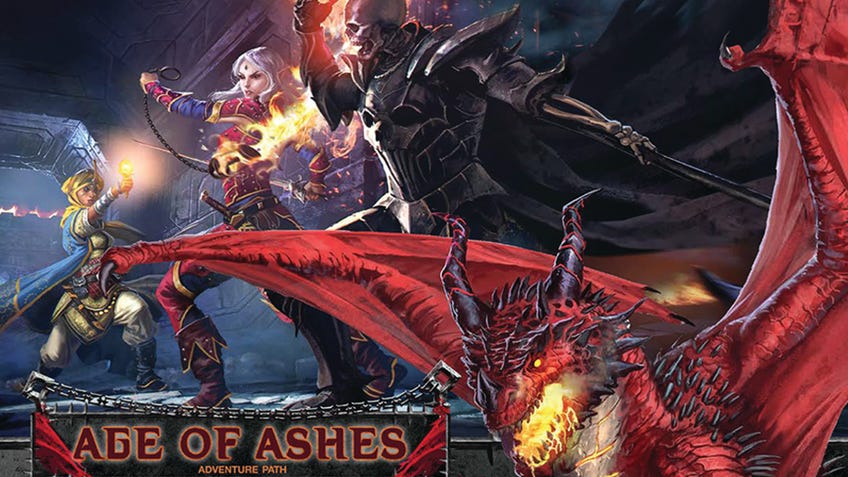
Adventure Paths rarely focus solely on fighting monsters and getting treasure, though there are plenty of dragons and slavers to fight over the course of Age of Ashes. Hellknight Hill opens with the party gathering in a town hall that is swiftly engulfed in flames, which they then must put out either directly or through helping townsfolk. There are tables and instructions for upgrading the citadel after the party conquers it, should they so choose to do so. In each volume, there is a balance between combat, exploration, and other activities that seek to show players the complete Pathfinder experience.
[Story spoilers for final Age of Ashes adventure Broken Promises follow]
Nowhere is this more apparent than in the final volume of Age of Ashes. In the penultimate chapter of volume six, Broken Promises, the party has the opportunity to engage in a debate with the dragon behind much of the villainy in the campaign in order to stop his slide into evil. Succeed, and they’ll gain boons that will prove helpful in the final confrontation. Fail, and they must prepare for an epic, difficult battle.
“It’s more interesting to me to let the players have an opportunity to talk it out with the villain and change their mind because it comes shortly before a series of challenging boss fights,” says Luis Loza, Paizo developer and author of Broken Promises. “I could show you a fight in every single encounter in the book, and by the end you’d know what a fight is. Plus, it showcases what a high-level skill contest would look like.”
[Spoilers end]
The elements Paizo developers pull from as inspirations for the content of Adventure Path volumes are as eclectic as they are diverse. Hamon says she wanted to capture the feel of a classic dungeon crawl when constructing the fortress in Hellknight Hill. Meanwhile, Loza says that Dr. Wiley’s Castle in the Mega Man series was a major influence in developing the climax of Broken Promises, as he aimed to recreate the feeling of a video game boss rush. As traditional a setting as Age of Ashes is, it's not a typical fantasy campaign - something that can also be said of the other Pathfinder Adventure Paths.
Age of Ashes concluded last December, giving way to a new Adventure Path that’s been in development for over a year. That Adventure Path is Extinction Curse, which focuses on a traveling circus, and will be followed by Agents of Edgewatch, which follows a group of city watch recruits in a campaign that has been compared to fantasy CSI.
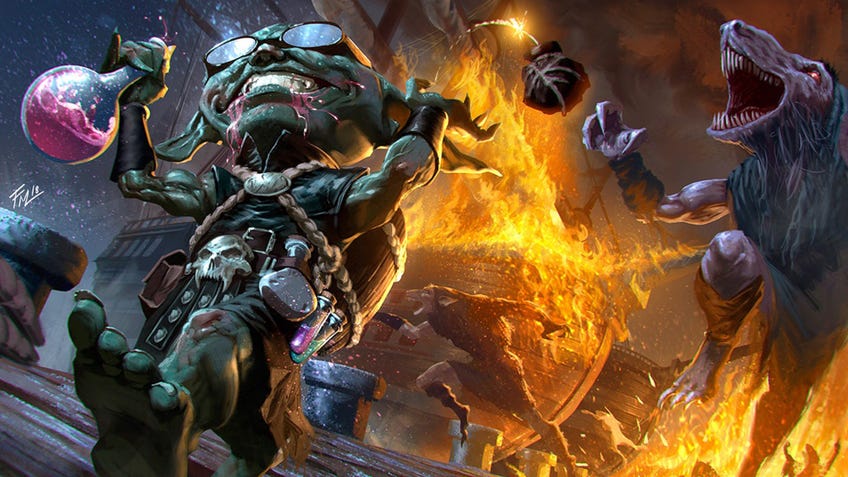
As for the future of Adventure Paths, Jacobs is keeping quiet on what’s to come, only promising that Paizo will continue to explore new ideas, and that the first Adventure Path of 2021 will be “really weird”.
“There’s a lot of things in the works that I hope players will be excited about that we’ve got in development, and I’m looking forward to showing what that is soon,” he says.
By the time the final volume comes out, I’m so tired of it and I can’t wait to start a new one.
Whatever future form they may take, few tabletop RPG lines match the consistency of Pathfinder’s Adventure Paths. For over a decade, they have guided players through a variety of campaigns that cover a gamut of inspirations and archetypes. Even if one Adventure Path doesn’t interest someone, the next one might very well do the trick. That change is something that Jacobs - and legions of players - continues to embrace every six months.
“My favourite [Adventure Path] is always the one I’m currently working on,” he notes. “And by the time the final volume comes out, I’m so tired of it and I can’t wait to start a new one.”
